Some people often avoid Hillside landscaping because they think it’s too hard to arrange.
The landscape is hard to walk and work on. Moreover, the topsoil is quite risky of having soil avalanche and running off the slope.
Yet, that doesn’t mean that you can’t do something to make a hillside landscaping fantastic and functional at the same time.
With a little extra effort and creativity, it’s possible to design as beautifully as any flat garden.
- Hillside Landscaping with Stone Steps and Low-maintenance Plants
- Four Planting Beds are Made of Semi-circular Retaining Walls in Low-maintenance Hillside Landscaping
- Low-maintenance Brick Formal Garden with Terraces in Hillside Landscaping
- Veneer Fieldstone Wall to Terrace the Hillside Landscaping with Low Maintenance Plantings
- Boulder Steps to Create Low-maintenance Hillside Landscaping
- Traditional Low Maintenance Hillside Landscaping with Walkway and Two Steps
- Large Hillside Landscaping with Low Maintenance Plantings in a Metal Planter Box
- Tuscan Low-maintenance Hillside Landscaping with Sloped Garden
- Incorporating a Water Feature in Low-maintenance Hillside Landscaping
- Dark Stone Steps in a Rock Low Maintenance Hillside Landscaping
- Concrete Slab Steps are Accentuated by Large Boulders in Low-maintenance Hillside Landscaping
- Tumbled Maytrx Block Retaining Walls in Rustic Low-maintenance Hillside Landscaping
- Creating an Outdoor Amphitheater in Low-maintenance Hillside Landscaping
Hillside landscape, on the other hand, has its own benefit. The existence of the slope can create original volume effects as long as you know how to landscape it.
To keep everything simple and minimalist, it’s recommended to use low-maintenance plants in a hillside landscape. The low-maintenance plants are meant to accentuate the whole garden.
Low-maintenance plants don’t have to be boring. There are a lot of plants and flowers in various colors.
Usually, people will create a staircase in hillside landscaping to create an instantly elegant look. Others add water features to their hillside yards.
The water feature in the steps will prevent the flow of water. Plus, it can make your garden even more attractive without too much effort to maintain it.
Still don’t know how to landscape your hillside garden with a low maintenance element to maintain slopes? Here are 13 looks that will spark your creativity:
1. Hillside Landscaping with Stone Steps and Low-maintenance Plants
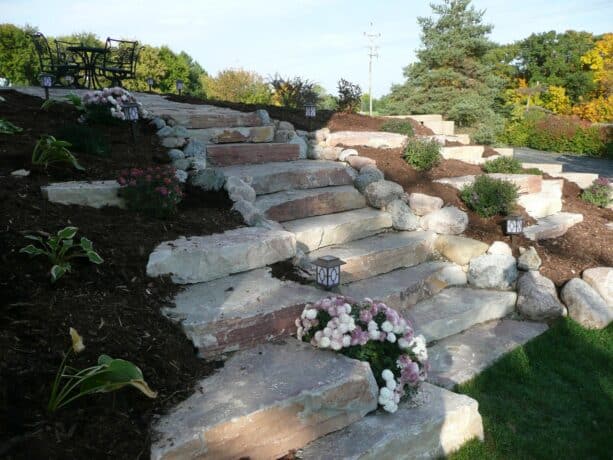
It’s important to add steps to your hillside landscaping, especially if it’s quite steep.
In this project, the designer utilized the areas, both lower and upper, connected by these stone steps. There is a stone patio complete with a small seating space on the upper level. On the lower level, it seems to be a lawn area.
Stone steps like this will never fail to add a bit of a rustic look to your landscape.
There are various types of stones that you can incorporate into your hillside landscaping. But if you want a sturdy look and a low-maintenance one, you can opt for a large chunk of stone slab like this to create steps.
Don’t forget to edge them with large boulders to create visual interest.
The designer also installed some stone slabs on both sides of the steps to anchor the soil. This is a more unique and simpler idea to anchor the soil rather than using retaining walls.
Even though there is no retaining wall that works as a planter box, the low-maintenance plants are still there, surrounding the stone steps.
The boulders and the low-maintenance plants are enough to accentuate the entire landscape.
2. Four Planting Beds are Made of Semi-circular Retaining Walls in Low-maintenance Hillside Landscaping
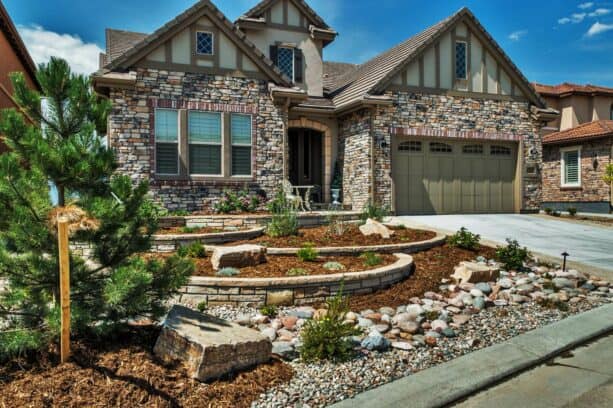
The designer of this project managed to create four flat planting beds out of four semi-circular buff strip stone retaining walls.
The planting area near the road is sloped to let proper water runoff. This is an ideal example of a large rustic partial sun front yard with a stone retaining wall to handle the hillside situation.
As you can see here, the hillside is not quite steep. That’s why the homeowners didn’t feel the need to build steps or a staircase.
The driveway on the right side is only a bit elevated, so visitors can actually handle the slope without any steps.
In order to add more anchors to the soil, the designer added some kinds of stones in the area that’s closest to the street. There are small rocks, pebbles, and even a large chunk of stone as a decoration.
Around, drought-tolerant and low maintenance plants were planted to add a splash of green color to a stone setting.
3. Low-maintenance Brick Formal Garden with Terraces in Hillside Landscaping
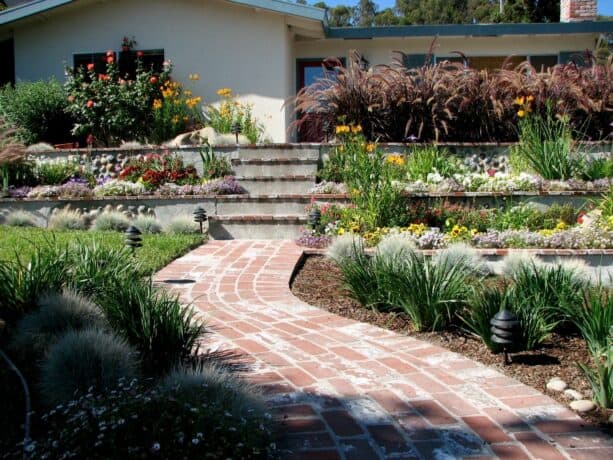
If you want a more structured, organized, and neater look, you can opt for this look. This is a lovely traditional full sun brick formal garden on a hillside landscaping.
In order to manage the slope, the designer built some steps made of concrete with brick tops. These steps are built right in the middle of the terraced retaining walls that serve as planter boxes.
The retaining walls are completed with a brick top to match the steps to create a seamless look. This way, the designer managed to add cohesion to this landscaping, making it neater and more polished.
Yet, the most stunning part of this hillside landscaping is the bright and colorful blossoms planted on the planter boxes.
On top of the walls, there are also various plants with colorful leaves and flowers to add a splash of color to the entire area.
Those are clearly not low-maintenance plants. But at least the retaining walls, the steps, and the path are quite low maintenance.
Bricks don’t really need regular care. They’ll just stay there for quite a long time.
4. Veneer Fieldstone Wall to Terrace the Hillside Landscaping with Low Maintenance Plantings
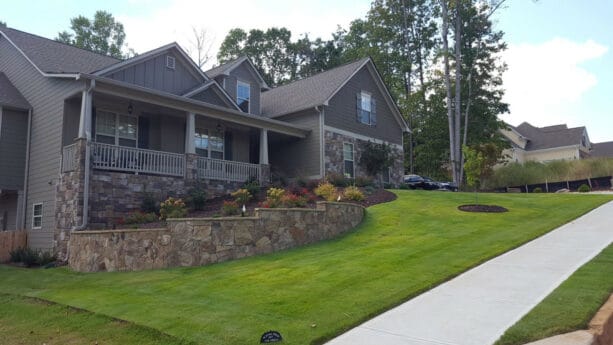
Even though this area is quite hilly, there’s only one retaining wall with several levels to anchor the soil. The rest of the front yard is planted with a ground cover to keep the soil stay in its place.
It’s obvious that a neatly mown lawn like this is not low-maintenance. It needs a regular trim to keep the lawn stay in shape.
However, the front bed is quite low maintenance.
According to the designer, this craftsman’s house used to have a poor landscape and grass. After that, the designer came to terrace the front bed with a veneer fieldstone wall, a strong and durable material that needs a little care.
They planted colorful and low-maintenance plantings on the planter bed to complement the house.
Keep in mind that low-maintenance plantings don’t have to look boring and plain. You see, in this planter bed, the plantings have beautiful bright colors that contrast the fieldstone retaining walls perfectly.
Always opt for colorful low-maintenance plants like this if you want something that looks warm and inviting in your front yard.
5. Boulder Steps to Create Low-maintenance Hillside Landscaping

It’s quite hard to see from this angle, but this garden had steep grades, according to the designer. And that was the biggest challenge in this project.
In order to create functional, attractive, and safe hillside landscaping, it was necessary to get creative with the boulders and the steps. The result is a huge contemporary styled drought-tolerant hillside stone garden, perfect for summer.
Stone is the dominant element in this area. That’s your best bet if you want to create low-maintenance hillside landscaping.
Stones, especially in a large slab like this, will help anchor the soil without extra effort. Moreover, if you incorporate a lot of stones in your landscape, you’ll turn it into a low-maintenance area because you don’t need plenty of plants.
Many stone landscaping only takes a very minimal plant to decorate the look.
In this project, there’s only a line of shrubs on one side of the stone steps. On both sides of the steps, there’s a ground cover for most of the entire area and towering trees at the far end of the area.
This is an excellent idea you can recreate if you don’t want to add too many colorful blossoms to your area.
6. Traditional Low Maintenance Hillside Landscaping with Walkway and Two Steps

If you want a polished and more structured look, it’s recommended to have a flagstone or stone like this. It seems that this is a natural stone, a variety of Montana Ledge Stone from Marenako’s Rock Center in Fall City, WA.
The ledge stone is used to create a terraced garden to retain the soil in this hillside landscaping.
There are two different steps. The first ones are built in the middle of the ledge stone steps, used to access the upper part, which seems to be a patio. The other steps are made of a large stone slab that leads to a gravel path in the upper path.
There’s a stone walkway that leads to stone slab steps, too. The walkway beautifully frames the retaining walls, separating them from the lawn area.
As usual, the terraced gardens are filled with low-maintenance plants. There are some shrubs and perennials with bright colored flowers to create a complementary look to the stone retaining walls.
If you want to use a stone as the main element in your hillside landscaping like this, don’t forget to add one big boulder or two, to complete the whole look.
7. Large Hillside Landscaping with Low Maintenance Plantings in a Metal Planter Box
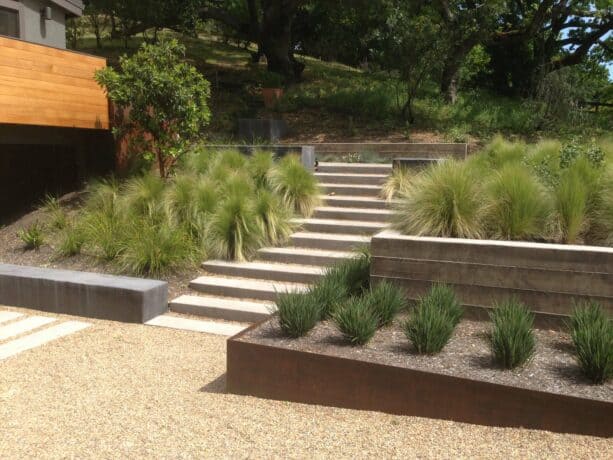
In a large and modern hillside landscape, it’s important to keep everything minimalist and lowkey. One of the key elements in a modern design is the simplicity, the polished look, and the neutral color palette.
This hillside area is not too steep, so it is not too high even though the designer incorporated a staircase.
This way, it’s possible for the designer to create a floating look for each step of the stairs. It appears that each step floats upon the gravel, which is 3/8” crushed rock, similar to the gravel area in the lower level.
On the right side of the concrete stairs, there are metal planter boxes that seem to be made of Cor-ten steel. On the left side, the landscaping is not terraced, but at the bottom, there’s a low concrete wall to retain the soil.
Both these areas are planted with low maintenance plantings, drought-tolerant types. The plants look similar to create a uniform look.
If you want to recreate this look, make sure to add metal, gravel, and concrete elements to your hillside landscaping because those elements are often associated with modern styled landscaping.
It would be better if you keep the plants low maintenance and similar to each other like this to achieve cohesion.
8. Tuscan Low-maintenance Hillside Landscaping with Sloped Garden
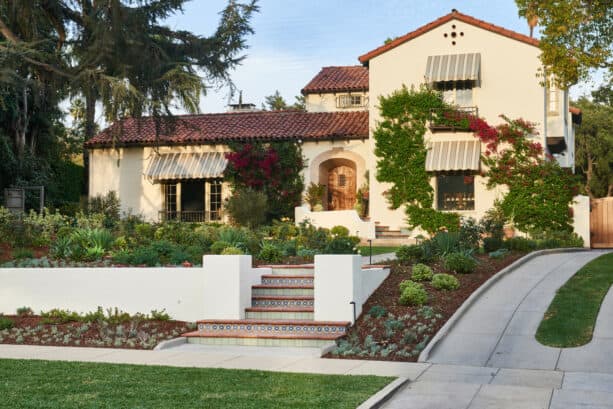
One of the most attractive things about a Tuscan or Mediterranean look is the patterned tile. You can always find it anywhere, in the interior or exterior design.
Just because you decorate your landscape or outdoor living space in a Tuscan design doesn’t mean you can’t incorporate patterned tiles like you usually see in a backsplash.
In this hillside landscaping, you won’t see multiple-level retaining walls. Instead, there’s only one retaining wall that seems to be made of stucco, another key element in a Tuscan look.
The wall has two columns bracketing the staircase. The staircase is situated in the middle, completed with patterned tile and a red-colored stone cap.
Actually, this hillside is a bit too steep. But the landscaper managed to handle the slope by building only one retaining wall, which is considerably low-maintenance because one retaining wall means fewer plants to handle.
Despite the steep slope, the designer built a staircase that is not as steep. It has a landing that serves as a path, too. This path leads to another staircase that opens to the main property entrance.
The plants consist of shrubs, bushes, and some trees that need no extra care as low maintenance plants.
9. Incorporating a Water Feature in Low-maintenance Hillside Landscaping
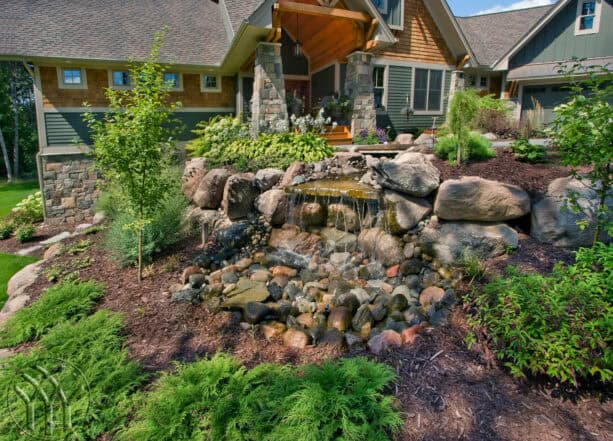
You’ve got it all wrong if you think that all hillside landscaping should incorporate retaining walls, planter boxes, steps, or staircases. It does take creativity to build something different like this.
In this project, instead of building retaining walls or a staircase, they built a majestic waterfall as a water feature in the garden.
This is a natural and rustic water feature that has plenty of rocks and big boulders. The big boulders are meant to anchor the soil and keep it in its place.
There’s one big slab of stone installed at the upper part that’s meant to be a spot where the water flows down to the rocks below.
It’s obvious that this hillside landscaping is not meant to be used as a hanging-out spot. It’s only used for aesthetic purposes only. There are greeneries planted around this imposing water feature to enhance the natural look.
If you want to recreate this look, you just have to count on these large boulders to retain your soil. It would be better if you used mulch as a ground cover.
Incorporating water features in your hillside landscaping is considered low-maintenance because rocks and boulders don’t need regular care like plants.
10. Dark Stone Steps in a Rock Low Maintenance Hillside Landscaping
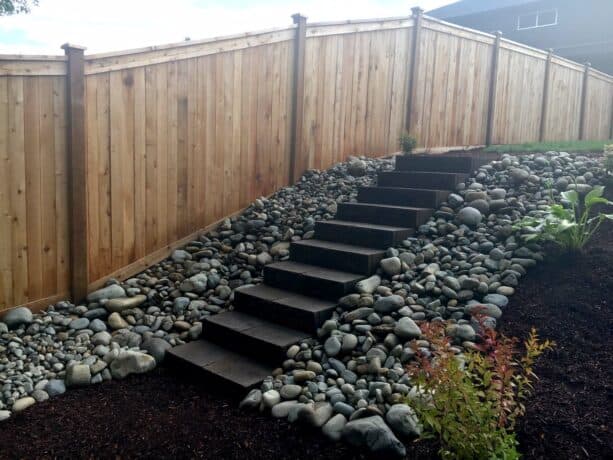
This is an ideal inspiration for transitional hillside landscaping.
There’s a large wooden fence as a border on one side of this area that promotes a traditional look. On the other hand, this hillside is filled with stone landscaping, a low-maintenance option if you don’t want to deal with a lot of plants.
Stone landscaping, especially in a neat, well-structured, and polished look like this, is often associated with a modern style. Moreover, the modern style usually has a neutral color palette.
In this project, it’s obvious that gray and black are used as the main color, two neutral colors that complement each other.
The steps are made of dark stone that contrasts the gray rocks around.
In the lower part of this landscaping, the ground is covered with dark-colored mulch. The only plants are only incorporated in the upper and lower part of the steps, clearly meant to accentuate it.
It’s easy to recreate this look. You just have to fill the landscape with mulch, build a stone landscaping around the steps, and build a wooden fence for a touch of traditional look.
11. Concrete Slab Steps are Accentuated by Large Boulders in Low-maintenance Hillside Landscaping
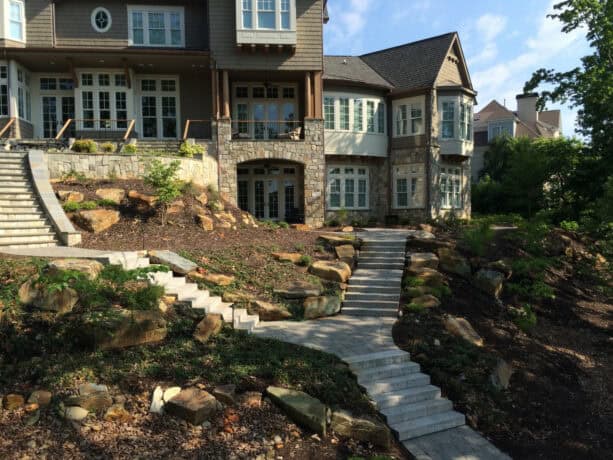
If space is not your problem, it would be better if you had multiple steps like this. Incorporating more than one step in your hillside landscaping will add elegance to your house, making it look more gracious and spacious.
A grade was retained in this hillside front yard using large boulders only. There is no retaining wall whatsoever to keep everything simple and low maintenance.
The large boulders were placed strategically to anchor the soil and keep it stay in its place. Bushes and grasses are planted in some areas clearly to accentuate the boulders.
There are concrete slab steps accompanied by a paver walkway that delivers a safe path to the lake because, according to the designer, this area had rear lake access, part of this hilly property.
The multi-steps have landings that lead to another area of this property, highlighting the greatness of the area.
This design has a rustic style with a partial sun type. That’s why it would be unwise to add a lot of plants because part of this hillside landscaping is quite shaded with a lack of sunlight.
The shaded area makes perfect low-maintenance landscaping because it means you’ll have to incorporate fewer plants in your space.
12. Tumbled Maytrx Block Retaining Walls in Rustic Low-maintenance Hillside Landscaping
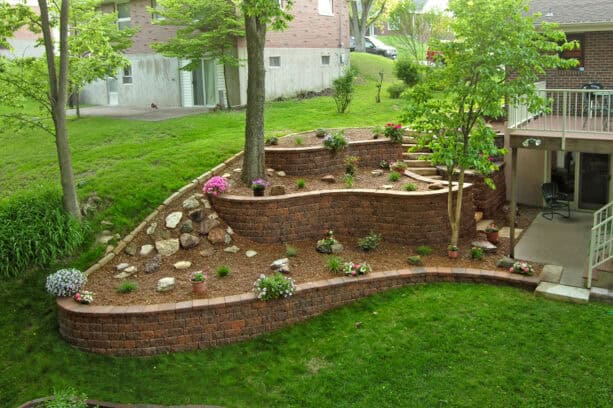
A rustic landscape doesn’t always have to consist of large boulders, rocks, and stone slabs that are set in a not-so-well-structured construction.
In this project, the hillside landscaping features a rustic look, but it is well organized, neat, and look sleek with clean lines.
Simple yet elegant, that’s the best way to describe this landscaping. It has a terraced garden with retaining walls made of tumbled Maytrx Block completed with matching caps.
Similar to the previous pictures, these retaining walls are also used as a planter box, and it has mulch as a ground cover. However, instead of planting the greeneries in the mulch, the designer added some small potted plants to these planter boxes.
There are some small bushes planted in the mulch, too, but they don’t look too imposing. It’s obvious that the small bushes are meant to be part of the backdrop.
The most striking element in this landscape is the bright and colorful flowering plants in the pots.
Large boulders are also placed strategically to help the retaining walls anchor the soil.
Instead of in the middle, steps were built on one side of the retaining walls, close to the front porch. These steps lead to another area of the property that’s situated on top of the hill.
You can copy this look if you want a total low-maintenance hillside landscaping like this.
The main idea is that you just have to build retaining walls as planter boxes. But, instead of planting some trees, shrubs, or bushes, turn them into some potting stations.
13. Creating an Outdoor Amphitheater in Low-maintenance Hillside Landscaping
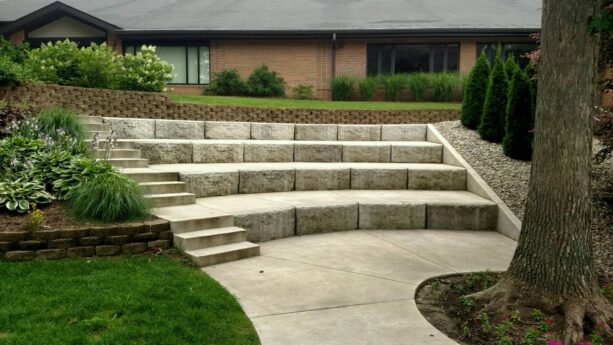
This is another neat and well-structured rustic hillside landscaping that you should see.
Instead of being made of natural stone slabs, this area is made of RAM concrete placed in the stone terra blocks, which are produced by Kuert Concrete, and poured into the surrounding concrete steps and slabs.
The great thing is, these retaining walls are not meant to be planter boxes like you’ve seen before. Instead, the designer made them be an outdoor amphitheater. The retaining walls are there, but they are placed on both sides of this outdoor amphitheater.
The walls are made of dark-colored blocks, not to contrast the amphitheater, but to be a backdrop for it, so the concrete amphitheater will get the most spotlight.
Below the concrete amphitheater, there are concrete slabs creating a circular area, with a big tree used as a focal point. On the left side, there are steps leading to the upper level, which is on the same ground level as the main house.
Of course, trees and other plants are also incorporated into this hillside landscaping. But, there are not plenty of them.
If you want low-maintenance hillside landscaping, it’s recommended to recreate this look. An outdoor amphitheater will deliver a unique look, both aesthetic and functional, at the same time, and you don’t have to deal with a lot of plants.
Leave a Reply